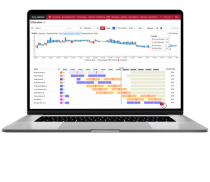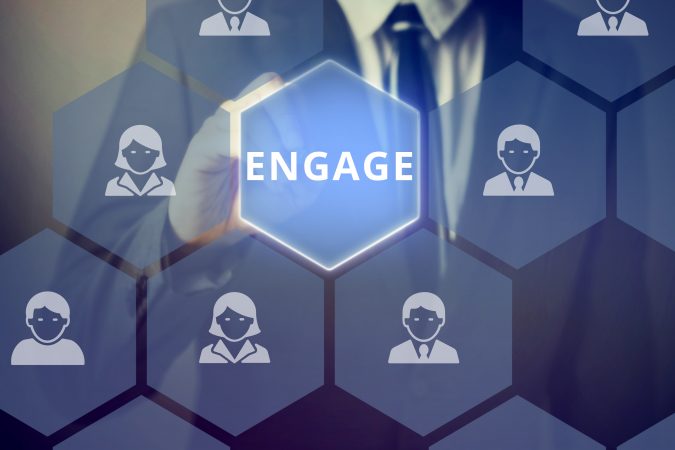- Products
- Solutions
Solutions
Services
- Resources
- Customers
Explore CSCCalabrio Success Center
Calabrio product training
- Partners
Customer ExperienceFind More Great Content- Customer Interaction Analytics
- Workforce Management
- Customer Experience
- Quality Management
- Contact Center Reporting
- Managing a Remote Workforce
Home » Workforce Optimization » Top 4 Ways to Elevate Agent Engagement in Your Contact Center
Top 4 Ways to Elevate Agent Engagement in Your Contact Center
If you think you’ve been hearing more about agent engagement—aka “workforce engagement management (WEM)”—lately, you’re probably right. With the increasing focus on the customer experience, better engagement with the agents who serve them makes perfect sense. After all, it’s a key way organizations can elevate and sustain the contact center customer experience by:
- decreasing agent attrition;
- arming agents with the tools they need to best serve customers;
- aligning customers with the specific agents best able to quickly and satisfactorily resolve their customer service inquiries; and
- adding the soft benefits agents crave.
That’s why Gartner predicts that by 2020, elevating employee engagement will become a key differentiator in more than 20 percent of contact centers, up from less than two percent in 2015.1
But this shift will require more than new tools—it will require contact center leaders to evolve the way they work and the ways in which they engage with their agents.
4 Ways to Elevate Agent Engagement in Your Contact Center
Here are four ideas to help you get started.
1. Empower Agents
All employees like to be heard and have their ideas considered, and contact center agents are no exception. One easy way to better empower your agents is to involve them in more business decisions, particularly ones that affect their processes and work environment.
As an example, you could involve your agents in the identification and selection of new training topics and technology tools that can help them deliver better customer experiences. For instance, many agents say the lack of customer data available to them at the time of a customer’s request hinders their ability to quickly resolve that inquiry. By involving agents in the resolution of this issue—which may turn out to be a combination of data, technology and process—you’ll make them feel empowered while solving a painful problem for both your business and your customers.
2. Measure What Matters
There’s no shortage of analytics available for understanding contact center data. Like any tool, however, how you use it is as important as when you use it. And when it comes to better engaging agents, you want to measure—and make business decisions based upon—the things that really matter.
For example, analytics used to identify new opportunities for self-service increase agent engagement because they essentially offload routine, mundane tasks to automated systems, so agents instead can spend their time servicing higher-value inquiries. Customers are happy because basic questions can be answered more quickly and more consistently, and agents are happy because their queues aren’t filled with simple inquiries best answered by other means.
3. Offer Flexible Scheduling
Agents—particularly Millennials—value work-life balance and expect it from their contact center leaders, who then need to balance those desires with staffing needs and work rules. As a result, one easy way to improve agent engagement is to offer a variety of scheduling options that recognize performance and seniority in tangible ways.
For instance, Calabrio’s Dynamic Scheduling goes beyond traditional and current shift bidding to better engage your agents, decrease agent churn and drive more efficient contact center operations.
It’s a multi-step process that melds the Voice of the Agent (VoA) with the needs of the contact center by inviting agents to select their preferred shifts based upon pre-established work rules, with priority selection awarded to high performers, those with seniority or those awarded some other type of performance-based distinction.
With meaningful rewards available to those who work toward being among the first to participate in the scheduling process, you incent engagement and foster a healthy, ongoing competition between agents.
4. Utilize Gamification
“Gamification” uses gaming science and psychology to increase agent productivity while reinforcing positive behaviors and teaching new skills. While gamification incents and recognizes agents—motivating them to meet or exceed expectations by completing specific objectives and outpacing peers—its ultimate goal is a customer-oriented one: superior experiences that result in longer-term and more satisfied customers.
We find most contact centers launch inaugural gamification initiatives that feature one or more of these three key strategies: rewards and recognition, peer competition, and training and development.
For instance, when it comes to rewards, recognition and peer competition, you could:
- develop a “leaderboard”—a dashboard displaying top performers and their “scores” against key metrics set ahead of time as goals for them—which agents actively monitor to see who leads, who’s falling behind, etc.;
- award “badges”—visual representations that track and measure agent status and advancement to higher levels according to different accomplishments;
- offer quarterly cash incentives to agents who maintain higher adherence numbers, productivity numbers and quality scores, and weekly cash incentives to agents with the lowest weekly wrap time and highest weekly adherence;
- use a BINGO card program where agents stamp a space when they complete designated activities (i.e., hitting their outbound call target) and demonstrate preferred behavior (i.e., achieving 100 percent schedule adherence), with agents achieving “BINGO” receiving a work-from-home day of their choice; and
- give gift cards to agents who meet quarterly key performance indicator (KPI), attendance and quality score targets.
Keep in mind, sometimes creative and inexpensive gifts—like giving each month’s top performer a reserved parking spot or additional time off, having a manager cover the phone while the agent takes a coffee break, or giving agents the option to work from home—are more memorable and valuable to agents.
When it comes to training and development, gamification often is used for both new-hire onboarding and ongoing skills development. You could:
- utilize the BINGO concept noted above again, this time to encourage sales trainees to keep top-of-mind the multiple product lines they need to sell, with trainees receiving a stamp from their manager each time they speak to a customer about a particular product focus area;
- use a “Hot Potato” ball throwing game to teach new agents what happens when one agent disengages from the team, such as by taking a break at the wrong time or calling in sick, etc.; and
- teach ongoing skills development via shared calls, coaching and standardized evaluation forms via a training program featuring a certain number of “bytes”—with each byte representing a skillset agents must master or complete—to advance upwards through their team hierarchy.
Agent engagement, or WEM, is quickly rising in criticality due largely to the changing expectations of contact center agents and the scarcity of high-caliber agents who can deliver stellar customer experiences. To engage and retain the professional, experienced agents your customers demand, you need to embrace new tactics like the ones listed above. Your agents—and your customers—will thank you.
1 Gartner, “The Essential Shift From Workforce Optimization to Workforce Engagement Management.” May 24, 2016.
Brad Snedeker is the Director of Customer Advocacy at Calabrio. With over 15 years in the industry, Brad has extensive knowledge of the contact center space. As Calabrio’s head of the Innovation Center, he works directly with users to teach and develop new and innovative techniques to implement customer engagement and WFO best practices.Recent PostsCalabrio is a trusted ally to leading brands. The digital foundation of a customer-centric contact center, the Calabrio ONE workforce performance suite helps enrich and understand human interactions, empowering your contact center as a brand guardian.
We maximize agent performance, exceed customer expectations, and boost workforce efficiency using connected data, AI-fueled analytics, automated workforce management and personalized coaching.
Only Calabrio ONE unites workforce optimization (WFO), agent engagement and business intelligence solutions into a true-cloud, fully integrated suite that adapts to your business.
For customers and partners.
© Copyright 2024 Calabrio, Inc.How to Use Call Center Games to Improve Agent PerformanceWhat came first the chicken or the egg? Happy customers or happy employees?Send this to a friend - Solutions













